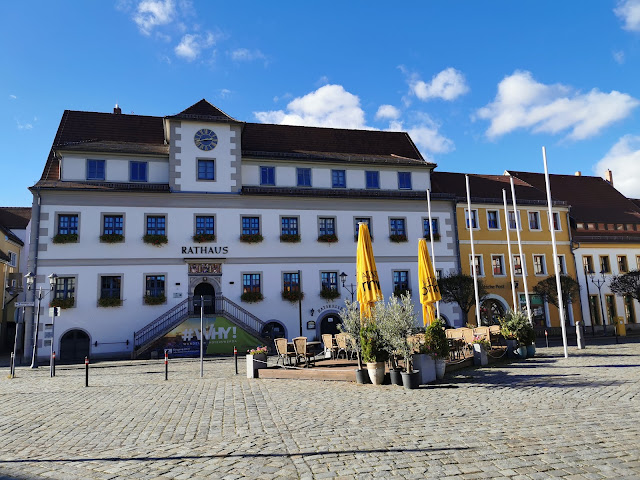On a still rather warm late October weekend, I decided to do a day trip from Berlin and head to the southern tip of Brandenburg. My first stop was the town of Ortrand which I reached after a switch of trains. Once there I headed through the small old town and reached the central square, the Markt. Here were some old buildings, including the town hall, and a nice refurbished saxon milepost from 1730 at its center. Walking through town I reached the main church, dedicated to St Barbara, featuring a baroque style but unfortunately closed when I tried entering it. At that point, I decided to head out of town and walk southwards, initially through some open countryside and later through a nice thick forest. After a bit of walking, with the final stretch all uphill, I reached the top of a small hill called the Kutschenberg. Although not isolated, but rather part of a low hill range on the border with Saxony, this is considered Brandenburg's highest hill at 201m above sea level. Due to the trees and surrounding hills, many of which were higher, at least on the Saxon side, the view wasn't anything worth it, but at least I had reached the region's highest natural point. I continued along the ridgeline, enjoying the nice view once in a while and the trees gave way to some open patches of land. At one point I decided to head back northwards, this time walking to the next village, Großkmehlen, close to Ortrand. As I approached it, I was happy to feel the strong and warm sun behind my back. I passed by the main church, St George, rebuilt in the 17th century and reached then the highlight of the place, the Schloss Großkmehlen. This castle was originally built in the 13th century but turned into its current baroque style during the 17th and 18th centuries. It features a central square plan and is surrounded by a moat and is thus considered a water castle. Unfortunately, as I reached the castle I found it closed so that meant continuing on my walk. I advanced further north, along a nice path sided by open countryside along the Pulsnitz River. After a while, I reached the village of Lindenau, and immediately approached its castle, Schloss Lindenau. This one was quite run down, with its exterior plasterwork falling off, and overgrown vegetation around. However, despite that, its baroque opulence was still a sight to behold. Right in front of it, was the baroque gatehouse leading to the main street of the village. On the other side of it were the 17th-century castle church and some nice farmers' houses. From there it was time to head back from where I had started. I took another route, following some paths through open fields and then over the autobahn as well. Eventually, I came back to Ortrand and here headed towards the train station after a nice loop hike. Once there, I took a train and reached the next town on my trip, Hoyerswerda, a few kilometers to the east, and part of the state of Saxony. After getting off the train, I headed through the old town, part of which had been preserved alongside the new town built after WWII under the German Democratic Republic. Particularly nice was the Lange Straße, a street once running on the inside of the medieval walls encircling the city, with some well-preserved 18th-century low townhouses. Moving on I reached the main square with the town hall, built in the 15th century and restored in the 17th century, and a Saxon milepost. Nearby I walked by the Schloss, a small baroque castle with inside the city museum, and around it the local zoo. Quite sad was the bear pit right below the building, on what was once the castle's moat. Finish off my walk around town I passed by the church of St John, a late gothic building which was closed when I tried entering. At that point, it was time for the last town of the day, Spremberg, which I reached with a short train ride. Once there, I walked through the old town, partly surviving with some historic parts and partly rebuilt after WWII. I first reached the main square, where the town hall is located with its nice 18th-century tower similar to that of a church. Walking onwards I reached the Kreuzkirche, a nice late gothic church dating to the 14th century with a tall tower topped by a spire in front a bit to the side. Continuing on my walk through town I then passed by the Schloss, a simple square castle originally dating to the 11th century but refurbished from the 18th century onwards. Today it holds the city museum which was closing just as I arrived there. Moving on, I walked through the nearby city park extending also up a hill. On top of it was the Bismarckturm built at the beginning of the 20th century. From there I enjoyed a nice view of the old town from above and a golden sunset to crown the nice and warm day.
 |
| Ortrand's main square |
 |
| The forest around the Kutschenberg |
 |
| Some friendly sheep |
 |
The nice open countryside
|
 |
| Großkmehlen's church |
 |
| Schloss Großkmehlen |
 |
| On the way to Lindenau |
 |
| Schloss Lindenau |
 |
| The castle church and gatehouse |
 |
| Hoyerswerda's old town |
 |
| The Lange Straße |
 |
| The town's main square |
 |
| The Kreuzkirche in Spremberg |
 |
| Schloss Spremberg |
 |
| View of the town and city park |

















































